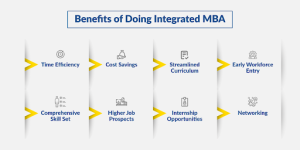
How to Do MBA – Step by Step Path to Your Degree
If you’ve ever wondered how to do MBA and whether it’s worth it, here’s a fact you should not miss: According to current data from India Today, the employability rate for Indian MBA graduates will increase to 78% in 2025.
The number highlights that MBA has been shifted from just a degree to a launchpad. So, if you’re in your final year of college or have been working for years, understanding the step-by-step process of how to do MBA is the first step toward transforming your career.
In this guide, we have listed every stage, from eligibility, entrance exams, to specializations and online learning options. By the end, you’ll know exactly how to do MBA in a way that works for your timeline, budget and goals.
Table Of Content
How to Do MBA After 12th: Early Career Planning
How to Do MBA After Graduation
How to Do MBA in India: Step-by-Step Admission Process
How to Choose The Right MBA Specialization
Online vs. Offline MBA: Which is Right for You?
How Jaro Education Can Help You with Your MBA Journey
Conclusion
Frequently Asked Questions
How to Do MBA After 12th: Early Career Planning

For those fresh out of school and already dreaming about corporate boardrooms or entrepreneurial ventures, you might be wondering: How to do MBA after 12th?
And the answer is: In India, you cannot directly enroll in a full MBA program after 12th because it requires a graduation degree but you can surely take an early-start approach. Here’s how:
- Choose the Right Bachelor’s Degree
- Popular undergraduate choices for future MBA aspirants include BBA (Bachelor of Business Administration), B.Com, Economics, or Engineering.
- However, your undergraduate major doesn’t limit your MBA options. How to do MBA successfully depends more on skills, profile and preparation than on your degree.
- Build Your Academic & Co-Curricular Profile
- Maintain a strong CGPA in college.
- Join clubs (business, entrepreneurship, finance), participate in debates and work on leadership roles in student organizations.
- Start MBA Entrance Exam Preparation Early
- Familiarize yourself with the CAT, XAT, MAT, NMAT and GMAT exam formats.
- If you plan for an MBA abroad, also consider the GRE or GMAT alongside the TOEFL/IELTS.
- Seek Internship Experience
- Even during your undergrad years, internships in marketing, finance, or operations give you practical exposure and make your MBA application stand out.
Pro Tip: If you want to keep your learning momentum, consider Integrated MBA Programs, which combine undergraduate and MBA studies into a single 5-year course.
How to Do MBA After Graduation
- Check Your Eligibility
- Indian B-schools typically demand 50% aggregate marks in graduation (45% for reserved categories).
- Higher GPAs or subject prerequisites may be demanded by some universities.
- Choose Your MBA Format
- Full-time MBA: Suitable for career switchers or campus-intensive aspirants.
- Executive MBA: Suitable for experienced working professionals.
- Online MBA: Flexible, industry-focused and growing popular among working professionals.
- Prepare for Entrance Exams
- National-level: CAT, XAT, MAT, CMAT
- University-specific: SNAP, NMAT, TISSNET
- International: GMAT, GRE
- Shortlist B-Schools Based on Ranking & ROI
- Shortlist B-Schools based on Ranking & ROI
- Verify NIRF rankings for India and QS rankings for international options.
- ROI is important: Look at the average placement package, tuition fee, and alumni network.
- Build a Strong Application Profile
- High scores on entrance exams
- Updated resume including internships, projects and extracurriculars
- Well-written Statement of Purpose (SOP) and Letters of Recommendation (LORs)
- Ace the GD/PI Round
- Group Discussions and Personal Interviews examine your communication skills, problem-solving skills and business knowledge.
How to Do MBA in India: Step-by-Step Admission Process

How to Choose The Right MBA Specialization
- Finance: For banking, investment and corporate finance roles.
- Marketing: Ideal for brand management, sales and digital marketing.
- Human Resource Management: Focuses on recruitment, training and organizational development.
- Operations & Supply Chain: Perfect for manufacturing and logistics sectors.
- Business Analytics: Combines data science with business strategy — highly in demand.
Online vs. Offline MBA: Which is Right for You?
How Jaro Education Can Help You with Your MBA Journey
We offer a curated range of online MBA programs that blend flexibility with academic excellence, perfect for professionals and graduates looking to master how to do an MBA without putting their careers on hold.
Some of our most sought-after programs include: Online MBA from Amity University, Online MBA by Manipal University Jaipur, and Online MBA from Dr. D.Y. Patil University.
Here are the reasons to choose Jaro Education:
- Flexibility Without Compromise: Learn from anywhere, at your own pace, with the same recognition as a full-time MBA.
- Top University Partnerships: Access programs from India’s most trusted universities with global credibility.
- Career-Centric Approach: Industry-relevant curriculum, placement assistance and skill-building for real-world success.
To put it all in short, when you choose Jaro Education, you’re not just learning how to do MBA, you’re preparing to lead with confidence in today’s competitive business world.
Conclusion
For those seeking flexibility without compromising on quality, Jaro Education programs blend academic rigour with practical skills to prepare you for leadership positions.
So, look no further and browse Jaro Education’s Online MBA Programs to begin your journey towards a brighter future.
Frequently Asked Questions
Many universities offer MBA programs without requiring CAT scores. If you’re exploring how to do MBA through alternate routes, you can consider NMAT, SNAP, MAT, or even direct admissions for online MBAs via Jaro Education’s partner universities.

